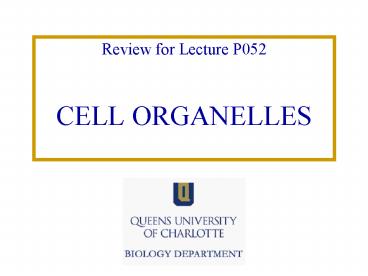CELL ORGANELLES - PowerPoint PPT Presentation
1 / 36
Title:
CELL ORGANELLES
Description:
Use the summary form to summarize the pulse-chase experiment of endomembrane ... 10-7 crista inside mitochondrion, ER, flagellum. 10-8 membrane, ribosome, microtubule ... – PowerPoint PPT presentation
Number of Views:78
Avg rating:3.0/5.0
Title: CELL ORGANELLES
1
CELL ORGANELLES
- Review for Lecture P052
2
TEST TAKE-HOME QUESTION
- Use the summary form to summarize the pulse-chase
experiment of endomembrane function as described
on textbook pp. 97b-99a and/or CD Activity 5.2 - 18 -36 points
- take-home section must be turned in with the test
or emailed before the test. - Honor Code
3
Experiment summaries
- Logical consistency
- hypothesis cause
- experiment measure
- results of measurements
- conclusion logical consistency
4
BASIC BIOCHEMISTRY
- Quiz 4. You MUST know these categories
- for Test 1.
- For understanding membranes and other cell parts
- for understanding genetics coming after test 1
- For reading newspapers
- for making personal decisions for health wealth
5
LAB this week
- Easy, learning skills for next experiment
- Turn in special chart (download LAB 3)
- Use lab resources to prepare for Test 1
- flash cards
- ask assistants and professor questions
- use lab computers to review
6
TEST PREPARATION http//campus.queens.edu/faculty
/jannr/bio103/tests/test1.htm
- Sign up for tutoring in the Learning Center in
McEwen Building. 6-8 today. Fri? - get together with a group of study-buddies. You
can study in the lab 24-7 if you have a permit
ask for one during your lab session. - Plan ahead avoid the traditional but ineffective
all-nighter you need to be able to think clearly
to do well on science tests.
7
Fluid mosaic hypothesis
- Fluid lipid bilayer.
- Mosaic protein floating in the bilayer
- vs older sandwich models outer layers of
protein (rejected) - you cant see a membrane (its too small you
only see a border with a light microscope) - circumstantial evidence from electron microscopes
8
- Which hypothesis do these data support?
- Fluid mosaic
- OR
- Sandwich
9
most important concept All cells have
- chromosomes,
- ribosomes,
- some type of energy-conversion system,
- and phospholipid membranes with protein channels
and enzymes.
10
Prokaryotes
- http//campus.queens.edu/faculty/jannr/cells/cellt
ables.doc
11
PROKARYOTES
- Oldest
- smallest
- membraneoutside
- wall alsousually
- but no...
12
Cell types
13
Eukaryotes
- Animals, including protozoa
- Plants
- Most algae and seaweeds
- fungi
- ALL with membrane-bound organelles
14
(No Transcript)
15
(No Transcript)
16
Animal cells have no walls
- http//www.med.uiuc.edu/histo/small/atlas/image/te
m17/14375a1.htm
17
18
Cell membrane face (left) and cell wall (right)
19
most important concept All cells have
- chromosomes,
- ribosomes,
- some type of energy-conversion system,
- and phospholipid membranes with protein channels
and enzymes.
20
Eukaryotes do some things within membrane-bound
organelles
21
Energy is used for motion and synthesis
22
In prokaryotes ATP is produced in the cytoplasm
and along the cell membrane
- In Eukaryotes most ATP is produced in
- mitochondria (both plants and animals)
- chloroplasts (plants only)
- (mitochondria, chloroplasts, and nuclei have two
phospholipid bilayers)
23
SIZE IS IMPORTANTin identifying cell parts
- 10-4 typical eukaryotic cell, plant vacuole
- 10-5 nucleus, chloroplast,
- 10-6 mitochondrion, large vesicles,
typical prokaryotes - ------- LIGHT WAVES-------------
- 10-7 crista inside mitochondrion, ER, flagellum
- 10-8 membrane, ribosome, microtubule
24
(No Transcript)
25
USING THE SCIENTIFIC METHOD TO EXPLAIN NUCLEAR
TRANSPORT. CD 5.1 and textbook
26
- http//www.sciencemag.org/cgi/content/full/301/56
38/1380/FIG3
27
- http//www.sciencemag.org/cgi/content/full/301/56
38/1380/FIG3
28
USING THE SCIENTIFIC METHOD TO DISCOVER THE
FUNCTIONS OF THE ENDOMEMBRANE SYSTEM. CD 5.2 and
textbook. And the signal hypothesis
29
Eukaryotes do some things within membrane-bound
organelles
30
(No Transcript)
31
(No Transcript)
32
Cnxns to chem
33
http//campus.queens.edu/faculty/jannr/cells/cellt
ables.doc
34
THE MAIN CELL TOOLS
35
most important concept All cells have
- chromosomes,
- ribosomes,
- some type of energy-conversion system,
- and phospholipid membranes with protein channels
and enzymes.
36
Chapter 5































